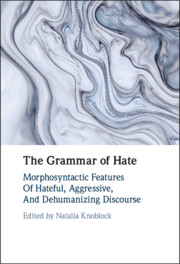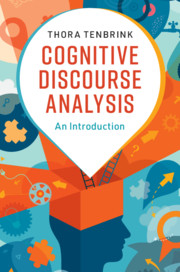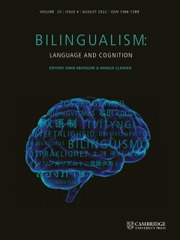The Grammar of Hate
Hate speech continues to be an issue of key social significance, yet while its lexical and discursive aspects have been widely studied, its grammatical traits have been hitherto overlooked. This book seeks to address this gap by bringing together a global team of scholars to explore the morphosyntactic features of hateful and aggressive discourse. Drawing on thirteen diverse cross-linguistic case studies, it reveals how hate is expressed in political discourse, slang, and social media, and towards a range of target groups relating to gender, sexual orientation, and ethnic identity. Based on ideas from functional and cognitive linguistics, each thematic part demonstrates how features such as morphology, word formation, pronoun use, and syntactic structures are manipulated for the purpose of expressing hostility and hate. An innovative approach to an age-old problem, this book is essential reading for researchers and students of hate speech and verbal aggression.
- Describes and analyzes morphosyntactic features of hateful and dehumanizing discourse
- Presents research on a variety of languages and a range of morphosyntactic features
- Concentrates on informal discourse in order to reflect actual, rather than prescribed, usage
Reviews & endorsements
'We need this book. Grammar in all its guises is given short-shrift in studies of hateful, aggressive discourse, yet even a cursory glance at the contents of this book will show that its neglect is not merited. An accessible, interesting, diverse, illuminating read!' Jonathan Culpeper, Professor of English Language and Linguistics, Lancaster University
'This book offers a leap forward towards better understanding aggressive, hateful, and dehumanizing communication from a morphosyntactic perspective contextualized by its social interactions.' Monica Cantero, Drew University
Product details
March 2025Paperback
9781108994347
309 pages
229 × 152 × 17 mm
0.451kg
Available
Table of Contents
- Introduction Natalia Knoblock
- 1. Animacy and countability of slurs: shifting grammatical categories Natalia Knoblock
- 2. Language aggression in English slang: the case of the -o suffix Elisa Mattiello
- 3. Adj+ie/y nominalisations in contemporary English: from diminution to pejoration Elizaveta Tarasova and José A. Sánchez Fajardo
- 4. Grammatical gender and offensiveness in modern Greek slang vocabulary Katerina Christopoulou, George J. Xydopoulos and Anastasios Tsangalidis
- 5. Unseen gender: Misgendering of transgender individuals in Czech Jonáš Thál and Irene Elmerot
- 6. The neutering neuter – grammatical gender in German and its discursive use in dehumanisation Miriam Lind and Damaris Nübling
- 7. Neutering unpopular politicians: the neuter gender and 'it' as a dehumanizing grammatical metaphor Natalia Knoblock and Yaroslava Sazonova
- 8. The power of a pronoun Linda Flores Ohlson
- 9. Is play on words fair play or dirty play: on ill-meaning use of morphological blending Natalia Beliaeva
- 10. Expressive German adjective and noun compounds in aggressive discourse: Morphopragmatic and sociolinguistic evidence from Austrian corpora Katharina Korecky-Kröll and Wolfgang U. Dressler
- 11. “Kill the invaders”: imperative verbs and their grammatical patients in Tarrant's The Great Replacement Robert Bianchi
- 12. 'I am no racist but…'. A corpus-based analysis of xenophobic hate speech constructions in danish and German social media discourse Klaus Geyer, Eckhard Bick and Andrea Kleene
- 13. Homophobic space-times: Lexicogrammatical and discourse-semantic aspects of the softscapes of hate David Peterson.





